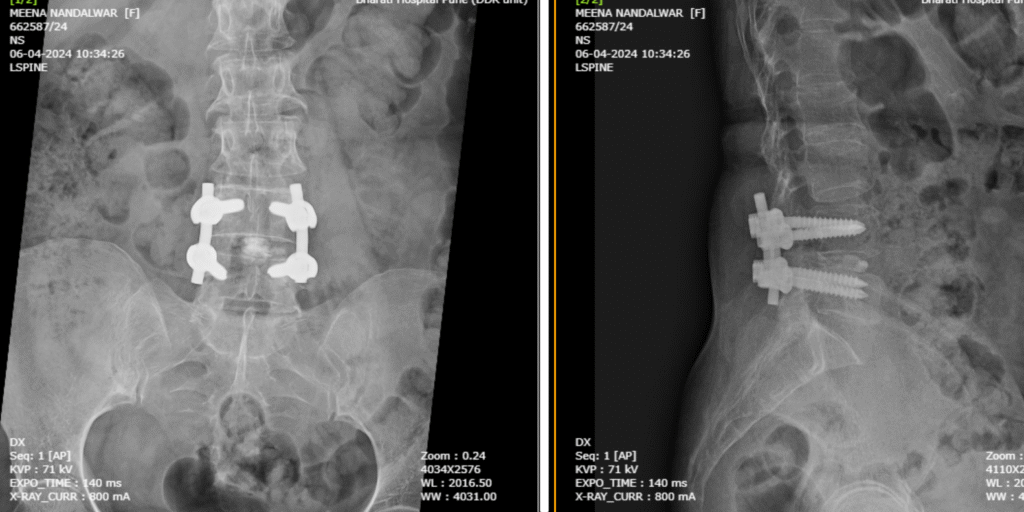Slip Disc Treatment and Lower Back Recovery Journey
Mrs. Nandalwar, a 48-year-old woman, visited our spine clinic with complaints of persistent low back pain that had lasted for five months. The pain radiated into her left leg and worsened while sitting, standing, or walking for prolonged periods. Additionally, she experienced numbness in her left leg, suggesting possible nerve compression in the lumbar spine—often a condition requiring timely slip disc treatment and lower back recovery measures.
She had no history of trauma, bowel or bladder dysfunction, or sleep disturbances. However, her medical history included diabetes mellitus for six years and leprosy diagnosed three decades ago. These underlying conditions made her case more complex, requiring a multidisciplinary approach.
Considering her symptoms and risk factors, our team created a personalized plan aimed at effective slip disc treatment and lower back recovery. The primary goal was to relieve nerve compression, restore spinal function, and ensure lasting mobility through targeted slip disc treatment and lower back recovery strategies.
Clinical Assessment for Slip Disc Treatment:
We began Mrs. Nandalwar’s assessment with a thorough physical and neurological examination to understand the extent of her symptoms and spinal condition.
Key Clinical Observations:
Spinal Posture: She had a noticeable forward-stooped posture, indicating discomfort and spinal misalignment.
Gait Pattern: She walked with an antalgic gait, adjusting her steps to avoid pain during movement.
Mobility Limitation: She was unable to stand or walk for long periods due to increasing lower back and leg discomfort.
These physical signs suggested spinal instability and mechanical stress on the lower lumbar region.
In her neurological assessment, we found no distal weakness, no reflex abnormalities, and no sensory loss in the lower limbs. This was a positive sign, as it indicated that nerve function had not yet deteriorated significantly.
Together, these clinical indicators pointed toward disc-related nerve root compression, which typically responds well to a structured slip disc treatment and lower back recovery plan. Early detection and intervention at this stage improve the likelihood of long-term relief and functional recovery.
Radiological Findings Supporting Slip Disc Treatment:
To confirm the diagnosis, we conducted an MRI scan of the lumbo-sacral spine and full spine. The imaging revealed:
L4-L5 disc prolapse with listhesis, showing disc herniation and vertebral slippage
Degenerative disc disease at L2-L3, indicating progressive disc wear
Old vertebral changes at L3, suggesting a past spinal injury
These spinal abnormalities clearly supported the need for immediate surgical slip disc treatment and lower back recovery, especially due to the structural compromise and risk of further spinal degeneration.
Before Surgery

Surgical Slip Disc Treatment Performed:
After discussing her options, we recommended surgery. Dr. Sangram Rajale performed a Soft TLIF (Transforaminal Lumbar Interbody Fusion) at the L4-L5 level. He used Sky Surgicals spinal implants to stabilize the spine and relieve nerve compression.
This active approach to slip disc treatment helped address both the herniated disc and spinal instability. Moreover, it laid the foundation for effective lower back recovery.
The goals of this surgical slip disc treatment included:
- Relieving nerve compression
- Stabilizing the spine
- Supporting long-term lower back recovery
Postoperative Progress and Recovery
After reviewing the MRI findings and explaining all available options, we recommended a surgical approach as the most effective solution. Mrs. Nandalwar agreed to proceed with the procedure for long-term relief and spinal stabilization.She resumed walking independently with walker support and bore weight on both legs. Her toe and ankle movements stayed active, and we observed no signs of nerve damage or vascular problems.
- Clinical Stability: Post-surgery, Mrs. Nandalwar remained stable without fever or complications. The surgical site healed well with a clean, dry suture line.
- Mobility: She could walk independently using walker support and demonstrated full weight-bearing capacity. Toes and ankle movements were active and preserved.
- Nerve Function: No neurovascular issues were observed post-surgery.
The goal of this slip disc treatment was not only to relieve pain but also to create a strong structural base for long-term lower back recovery. By addressing both the disc prolapse and instability in one surgical session, we ensured better outcomes and reduced the risk of future complications.
After Surgery

Strengthening Lower Back Recovery with Rehabilitation:
We initiated her lower back recovery immediately through a supervised physiotherapy plan. As her radicular pain reduced, her spinal alignment improved noticeably. Regular exercise sessions focused on mobility, core strengthening, and gait correction.
Consequently, her independence improved with each day. She gradually returned to basic daily activities without support. In addition, continuous follow-up and guided rehabilitation ensured a stable path to full lower back recovery.
Following the surgical slip disc treatment, Mrs. Nandalwar experienced:
Significant relief in radicular pain
Improved spinal alignment
Better posture and walking ability
Ongoing lower back recovery with physiotherapy and functional exercises
She continues to show steady progress through regular follow-ups and guided rehabilitation.
Conclusion: A Successful Slip Disc Treatment and Lower Back Recovery
Mrs. Nandalwar’s case is a strong example of how precise diagnosis and timely intervention can transform a patient’s quality of life. Through expert-led slip disc treatment and lower back recovery, including advanced spine surgery, she regained mobility, reduced her pain, and resumed an active lifestyle.
Her journey underscores the importance of personalized care, advanced imaging, and evidence-based treatment strategies in achieving long-term success in spinal health management.
